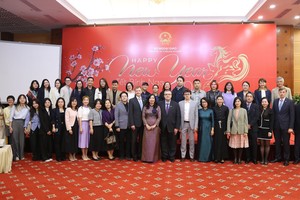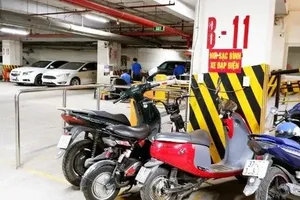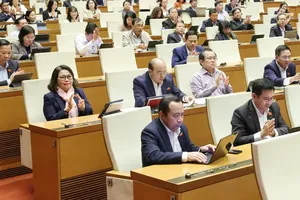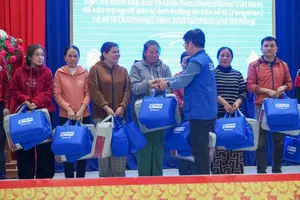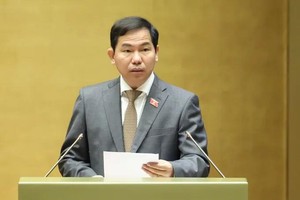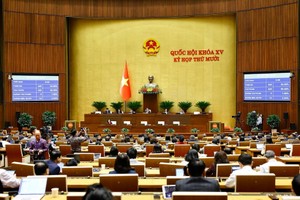
First, NA Deputy Hoang Minh Hieu introduced the ultimate objective to be achieved through administrative streamlining as stated in Resolution No.18-NQ/TW dated October 25, 2017, by the 12th Party Central Committee on “Several Issues Regarding Continued Renovation and Organizational Restructuring of the Political System towards Enhanced Effectiveness, and Efficiency”.
Accordingly, the overall goal is to strengthen the Party's leadership role; enhance the State's management effectiveness and efficiency; improve the operational quality of the Fatherland Front Committee as well as political-social organizations; and promote citizens' sovereignty.
Thus, administrative streamlining must be intrinsically linked to structural reorganization, elevating the quality and efficiency of personnel utilization, reducing recurring expenditures, and contributing to wage policy reforms.
Answering the concern whether this streamlining might lead to overloading or delays in processing administrative papers, Deputy Hoang Minh Hieu said that initially, organizational restructuring will necessitate reviewing and refining implementation procedures, which may temporarily impact work efficiency. However, the fundamental goal is to enhance public service delivery. By reducing bureaucracy, simplifying procedures, and leveraging technology, the government aims to provide faster and more effective services to citizens.

The Deputy then listed the criteria used to evaluate the effectiveness and success of administrative streamlining.
Specific metrics must be established to assess recurring expenditure reduction, the extent of administrative staff reduction, and the number of eliminated intermediate organizational units. Particularly crucial are criteria evaluating procedural simplification and reduced citizen service processing times. Finally, the most comprehensive and significant evaluation criterion is the impact of organizational restructuring on the nation's socio-economic development speed and quality.
Discussing possible challenges emerging in this important task as well as necessary expenditure to complete it, Deputy Hoang Minh Hieu shared that any reform process inevitably confronts challenges, with obsolete working habits being the most formidable. Persisting with old methodologies will fail to meet reform requirements. Therefore, the streamlining process must be implemented scientifically and with high consensus.
Since administrative streamlining targets recurring expenditure reduction, the process's implementation costs will fundamentally trend positively. If executed effectively, citizens will benefit through more seamless procedural resolutions, and the state will secure additional budgetary resources to invest in critical projects that stimulate socio-economic development and enhance public life.
Explaining the supporting role of IT in this streamlining task, the Deputy said that the government's successful implementation of IT has significantly enhanced efficiency and transparency. Online public service systems and national database development have simplified processes, reduced costs, and improved service delivery.
By automating tasks, reducing manual labor, and improving inter-departmental collaboration, technology is helping to streamline the government apparatus. This includes minimizing direct citizen-government interactions through online public services, increasing convenience and reducing costs. Additionally, information systems can monitor the performance of government agencies and civil servants, promoting accountability and efficiency.
A critical matter is to mitigate negative impacts on surplus personnel and their families. Deputy Hoang Minh Hieu shared that civil service legislation already includes specific provisions for managing surplus labor reorganization. Recently, the government issued Decree No. 20/2023/ND-CP dated June 3, 2023, concerning administrative streamlining, which includes policies for personnel termination and early retirement.
Based on these regulations, to meet upcoming administrative streamlining requirements, policies addressing surplus labor will continue to be refined, ensuring alignment with Resolution 18’s objective of “securing sufficient resources and implementing appropriate mechanisms for directly affected officials and employees” and “fostering unified Party comprehension and societal consensus”.
Finally, discussing the methods to sustain and develop the obtained achievements in this streamlining task, he commented that to achieve the goal of becoming a socialist-oriented developed nation by mid-21st century, state apparatus renovation and improvement in Vietnam must be conducted continuously and systematically, responding to emerging contextual demands.
Particularly in the context of globalization, digital transformation, and evolving public management, notable administrative reform trends include focusing on digital transformation to modernize administrative structures and minimizing bureaucratic procedures; adopting innovative public governance models emphasizing performance-based management; increasing operational transparency; encouraging citizen and enterprise participation in policy formulation; and training civil servants in technological and modern management skills.




